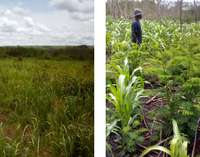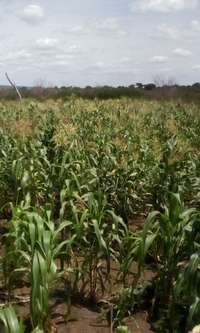Deforestation, overused soils, increasing competition for land, and climate change have made subsistence farming in much of Central Africa a precarious occupation. Malnutrition is on the rise, and local economies have declined in many places. The use of leguminous trees in agroforestry systems addresses these problems.

Figure 10. Grassland (left) before growing maize with Acacia angustissima (right). Source: Paul Noren
While working on various agricultural projects in Northwest Congo in the mid-1980s, we worked with a young farmer group in Botolofionamed “Tembe na Mbeli,” an idiom in Lingala for “Don’t doubt the power of a machete.” These young men were out to prove that a good machete and a willing spirit could accomplish something worthwhile. The tall tropical forest that once characterized the area years ago had become open grassland dominated by Imperata cylindricum, a tough sword grass that thrives in areas with poor soil quality. One of the things we suggested to this group was to do a collective planting of 0.25 ha of Acacia angustissima trees as a reforestation and soil improvement experiment (Figure 10). The trees start as a single stem but eventually develop into multi-stemmed clumps with deep roots. The farmer group members were willing to plant them, so we provided the seedlings and planting instructions.
The trees did so well that they shaded out the sword grass and impressed the farmer group members enough that each of them then planted a plot of their own. The practice spread when other people in the village saw the resulting maize production. Women benefitted because they no longer had to search for firewood. Now, most people in the village plant this tree in rotation with food crops. The process involves:
- Planting A. angustissima seedlings from a nursery7 into a field at 3 m x 3 m spacing. In Botolofio, farmers plant the trees into a cowpea and cassava field, but you can try alternative first-year crops.
- Harvesting cowpea when mature and cassava after one year
- Allowing the trees to grow for three years (two years after harvesting cassava), shading out sword grass
- Preparing for maize planting by cutting the trees for fuelwood, leaving the stumps in place for future regrowth (Figure 11)
- Lightly burning the field and sowing maize
- Allowing stems to develop from the A. angustissima stumps and selectively pruning regrowth while maize is growing (otherwise the trees’ regrowth will compete with the maize)
- Repeating steps two to seven on rotational patches of land to ensure production of all staple crops on an annual basis

Figure 11. Fuelwood from Acacia angustissima trees (A and B) cut before planting maize among remaining stumps (C). Source: Paul Noren.
That all began 35 years ago. Today the people at Botolofio say they live because of Acacia angustissima trees. They get all the firewood they need from their trees and most of the building poles they want (Figure 11). My own trials in the area, show that one can only expect 350 kg of corn per hectare in a season, even when the land is not cropped each year. The people at Botolofio produce 1.5-3 t/ha (metric tonnes per hectare) now, where the A. angustissima trees have been growing. My own trials in the area show that the increase can be estimated to be over three times to about nine times what they used to get. The change is enormous.

Figure 12. Healthy maize, during a short drought, growing with previously cut A. angustissima trees. Source: Paul Noren
This past year (2020), I paid the village of Botolofio a couple of visits and saw additional advantages the trees bring to the farming system. Trees shade out the grass until the grass is gone and just leaf mulch remains, significantly reducing weeding requirements. Women in the village benefit from this as they perform the bulk of weeding management. Secondly, some maize planted early, matured and was harvested earlier than in other villages, even after a drier than usual dry season. I was amazed at the maize and the apparent lack of effect of a short drought on its performance (Figure 12). The trees were conserving moisture better than the grassland vegetation. During a crucial growth stage for the corn, the root systems of the trees seemed to help with moisture availability even though little remained of the above-ground portion of the trees. My guide, Mr. Ngovene, one of the original planters, pointed out how much better even the wild grass looked near an isolated A. angustissima tree. Surrounding stands of A. angustissima trees also act as windbreaks, which seemed to keep humidity higher.
The people of Botolofio are still planting new fields of A. angustissima trees today, and there are plenty of seedlings to be found. They have a system of trimming and bare rooting the seedlings that are then immediately planted within the surrounding 500 m. The success rate is quite high, and the trees completely shade out the ground within a year.
So far, this system has not spread to other villages very much. It appears that transplanting the bare rooted seedlings only works for neighboring fields, thus making it very unlikely that someone even 10 km away would succeed if they tried. To move the system from one village to another, more than 3 km from each other, takes a lot of preparation. You need to gather seeds during the dry season, plant seeds in a nursery, and then transplant seedlings into planting bags. You would have to set up a nursery, water trees, and purchase planting sacks. These requirements effectively exclude the poor farmer from getting the system started in a new place. Even so, one or two small plots of A. angustissima have been planted by local people as far away as 30 km from Botofolio.
This system can be improved upon, but has great merit as a mid-to-long-term solution to food, fuelwood, and building material production. It has proven itself for over 30 years and will continue to expand until a better system replaces it. Hopefully, we can help extend the area in which this system is practiced—[Trial packets of A. angustissima seeds are available via ECHOcommunity.org].
Cite this article as:
Noren, P. 2021. Acacia angustissima Farming Improvement Experience. ECHO Development Notes no. 152.